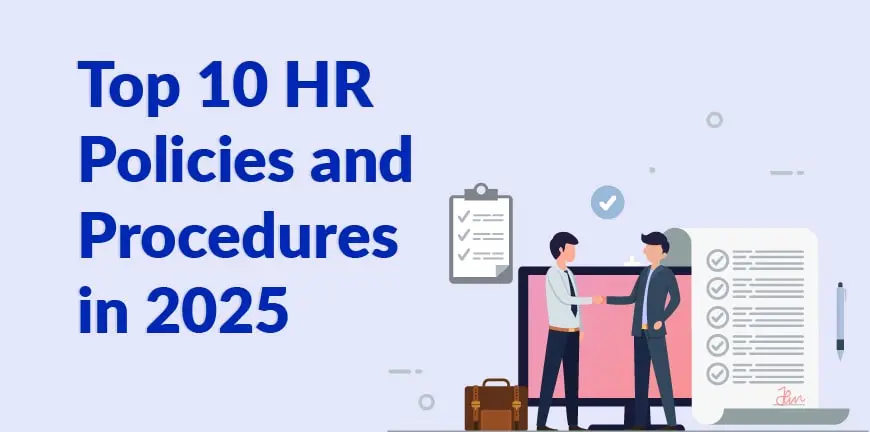
Important HR Policies For Startup Company in India
06/07/2022Top 5 RPO Models for better RPO Engagements
24/07/2022The way we work has changed forever. 2021 saw the emergence of new norms and habits at workplaces as businesses adapted to operating during and post the pandemic. 2022 is the year to execute those lessons, along with up-gradation and in-depth efficiency.
Organizations and employees have seen some popular trends in human resource management, let’s take a look at them closely.
Top 10 HR Trends
1. Employee Well-being is Prioritized
68% of HR leaders rated employee well-being and mental health as a top priority.1
The pandemic has made corporates realize that employee well-being is a core aspect of the functioning of an organization. It has expanded beyond physical well-being to include emotional, financial, social and career wellness.
Many companies have now adopted a leave policy to include not just sick leaves but also wellness leaves. Many large companies such as Hindustan Unilever, Nestle India, L’Oreal India, Mondelez India, GSK Consumer Healthcare and Godrej Group, as well as multinational technology majors like Google and Twitter, adopted wellness leaves during the pandemic.
A study conducted by Boston Consulting Group study of working parents across five countries in Europe and the U.S. revealed that 60% of working parents were unable to find alternative care following school and daycare closures.2 This caused them to spend as much as 27 more hours per week on household chores, children and their education. This was roughly equivalent to working a second job.
In order to minimize the strain on their employees, companies provided support for working parents with home-schooling, paid parental leave and providing more flexibility around work schedules. These were among the few HR trends of 2022 that caught the eye of the world.
2. Adaptation to Hybrid Work Model
One of the most popular HR trends that were quick for companies to adopt was a hybrid working model. Offering employee-centric flexible work, it includes a mix of in-office and remote work, keeping safety and welfare in mind. 81% of businesses believe hybrid work to be the most preferred work model by 2024.3 The post-pandemic effect on workplaces included a more suitable approach for employees and their productivity.
Allowing employees to opt for long-term work from home has also been on the rise, making companies cut down operations costs drastically. Both of these encourage employees to work at ease while functioning from their own comfort space.
3. Upgradation of Digital Skills
Working remotely throughout the pandemic has made firms realize the importance of digital skills. While employees have mastered some of them, some are still in the learning phase. Companies have relied largely on a variety of tools from Zoom and Webex to Microsoft Teams and Slack. In fact, over the course of May 2020, Zoom was seeing 200 million daily meeting participants as more people switched to collaboration online.4
Not to forget some game-changers in the virtual reality world like Strivr, Immerse, and BodySwaps. These technological upgrades are not only gaining popularity as HR trends but will remain to function effectively in the corporate world.
4. Rise of Skill-Based Hiring
More companies are taking up the practice of setting specific skills and competency requirements for a job rather than looking at a candidate’s previous experience or certificates.
Harvard Business Review partnered with a leading labor-market data company, Emsi Burning Glass, to conduct a survey for more than 51 million jobs posted between 2017 and 2020.5
They found that employees are setting degree requirements across a range of jobs by favoring jobs hiring on basis of skills.
Skills-based hiring offers two major benefits:
- It expands the prospective talent pool.
- it gives internal employees opportunities to understand the educational pathways for specific industries and job functions.
Employees that are exceptionally good at their job are more productive and also have a clearer professional path ahead of them.
5. Implementing Improvement Programs
Companies are constantly striving to improve and excel in everything they do. The pandemic has made them realize the importance of upgrading — from hiring quality employees to administrative paper processing to meeting customer needs. These trends in human resource management have had a larger positive impact on the firm.
These programs have to be organized well with the support of the top management and driven by collaborative efforts. The HR ensures employees gain maxim benefit from these well-planned programs.
6. Building Diversity and Equity Inclusion
Along with expectations of greater empathy and employee well-being, the HR trends today include increasing demand to improve equity and inclusion within organizations. A 2019 survey revealed that people of color made up only five percent of employees at Silicon Valley tech firms, and women hold around just 28 percent of tech industry roles.6
The stakeholders of companies are particular about hiring, both internally and externally to make their workplace diverse and inclusive. The constant need to ensure building a safe and diverse workplace is only going to get more crucial as an HR trend in the future.
7. Creating a Contingent Workforce
The significant rise in contingent workers is one of the recent trends in HRM Contingent workforce are individuals typically hired for shorter periods of time. A large part of today’s modern-day workforce includes a labor pool that includes employees hired on a project basis or for a fixed period of time. These consultants, freelancers and part-time or on-call workers are hired to perform specific tasks that often require a special set of skills and are employed when a firm is experiencing significant deviations in its workflow.
The rise in the contingent workforce is attributed to the growing need for people with specific skills that are hard for companies to find. It also provides flexibility to businesses as well as the employer.
8. Decentralized Workplaces
The pandemic has made companies opt for employees who are stationed anywhere around the globe. A workstation and wifi are all you need to get hired across the globe. This recent trend in HRM is catching up fast as organizations are turning to be more and more decentralized. With this potential, employers no longer have to consider relocating for a job and companies no longer have to rent workspaces.
Businesses have had the liberty to function at their own pace and cut down logistical costs. Along with that, firms can now take full advantage of a diverse workforce.
9. Virtual Team Building Activities
As more people adapt to remote working and a fairly new HR trend, the employee experience saw some significant changes in team building. Meeting your colleagues, having meals together and attending workshops and conferences together, were all a part of getting to know your team better. All of these changed in recent times. HR redesigned them into virtual experiences to suit the situation and get everyone more involved even during a crisis.
Virtual team meetings offered an opportunity for employees to interact and have fun without being onsite. These were strategically designed by the HR that included team games and helped build engagement. Online office games such as virtual team building Bingo, virtual show and tell, etc., virtual campfires that included trivia and ghost stories, healthy lifestyle challenges and more.
10. Digital Tracking
One of the most challenging HR trends is tracking employees digitally. Traditionally, an employee would walk into their office, scan their ID card or use a fingerprint machine to mark their attendance. Today, with remote working, companies have made a massive transition into using online tools — virtual timesheets, virtual attendance and virtual performance management to name a few.
The new world of work requires, leaders, HR and employees to be flexible to quickly adapt to changes in the future. Not just with the health crisis but also with technological advancement. More and more companies are carefully curating their policies to include the well-being and comfort of employees, understanding that they are a significant asset to their firms.
One of the most important trends in human resource management is that organizations now need to demonstrate resilience, empathy, transparency and digital fluency to ensure everyone is involved and has a voice in creating the future of work.
Frequently Asked Questions
1. What factors are driving the top 5 priorities for HR in 2022?
There are 5 major factors that will drive the HR trends in 2022:
- Focus on the quality of work that contributes to productivity; Leveraging technology to improve the work experience for employees; Offering the best workplace experience in terms of flexibility based on a hybrid or remote work model.
- 29% of the skills that were present in an average job posting in 2018 will be obsolete by 2022.7 There is an increased demand for skilled employees. Skill development will be incorporated into the talent management process when they join and as they evolve.
- Since the pandemic, the latest HR trends also include an emphasis on complete employee well-being. It goes beyond physical well-being to include mental, emotional, financial, career and social wellness and will continue to focus on supporting employees both professionally and personally.
- Companies are adopting diversity, equity and inclusion as an integral part of the work culture. 36% of HRs say they have difficulty holding management accountable to Diversity, Equity and Inclusion (DE&I) goals.8 Inclusivity and diversity build employee trust and more and more companies are realising its importance.
- The future is hybrid. Home, office or work from anywhere is an acceptable HR trend. In fact, 95% of HR executives believe that a portion of their workers continues to work in a remote capacity post-pandemic.8 Companies need to make sure their business, operations and processes are aligned with the work style their employees prefer.
2. What should HR teams focus on in 2022?
Today HR trends revolve around elevating the employee experience no matter where they choose to work from. This includes the aspects of flexibility, diversity, inclusivity and employee wellness.
3. Future HR trends: what’s next?
Keeping up with the HR trends, companies need to incline towards complete digital transformation, building employee experience and offering workplace flexibility. There’s a huge competition for talent and employees. Today won’t settle for workplaces with unhealthy cultures or unrealistic performance expectations that call for stress and compromise on their well-being.
With little to no support from leaders, inadequate compensation and lack of meaningful work, the attrition rate is sure to shoot up if the business does not keep up with the workforce demands.
Companies need to keep up with the trends in human resource management by improving the overall employee experience and creating a work environment for growth, efficiency and well-being.





